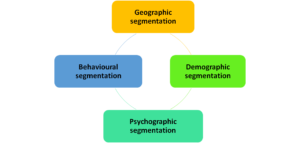Contents
List of market segmentation examples
Click on the links below to find many examples of how to segment markets, using different segmentation bases. These segmentation examples are designed as a guide to help you understand how the market segmentation process is undertaken, as well as understanding the effectiveness of segmenting a market in order to understand consumers and their motivations and their behaviors.
List of market segment ideas – ideal for creating your own segments
Market segmentation example for sports shoes
Market segmentation example for grocery shoppers
Market segmentation example for retailers
Market segmentation example for airlines
Market segmentation example for fast food
Example market segmentation for cars
Market segmentation example for banks
Another bank segmentation example
Example market segmentation for breakfast foods
Example market segmentation for car insurance
Example segmentation approach for drinks
Market segmentation example for charities
Example market segmentation for fitness centers
Quick market segmentation examples
Business segmentation examples
The four main Approaches to market segmentation = choice of segmentation bases

Market segmentation is a fundamental aspect of marketing strategy and marketing mix development. There are four top-level segmentation bases that can be used. Each of these top-level bases have numerous components, which can be used interchangeably and collectively to segment customers into homogeneous groups.
These top-level segmentation bases are:
Geographic
Geographic segmentation is segmenting on various aspects of the geographic location of the consumer (or the business in B2B marketing).
It is an effective segmentation tool when the geographic region creates similar needs. This will occur due to cultural aspects (people living in the same area having the similar lifestyles), climate factors (affecting clothing, transport, housing), access to facilities (e.g. living near a beach versus living in a regional area).
Demographic
Demographic segmentation is segmenting the population on its characteristics – such as age, income, gender, occupation, and so on. Demographic segmentation is a useful tool for segment profiling.
This approach to segmentation is also effective when the population characteristics being used to define the segment will drive similar consumer behaviors and purchase decisions. A simple example here is that people in their late teens and early 20s are far more likely to be heavy consumers of universities and colleges. Likewise, older retired people are more likely to be users of health services and travel agencies.
Psychographic
Psychographic segmentation is segmenting on the consumer’s attitudes, lifestyles, values, and so on. In other words, looking at the consumer as a “person”, rather than as just a consumer.
This approach to segmentation is very helpful in understanding the WHY consumers make certain decisions and why those products/brands are important to them.
Behavioral
The fourth main segmentation base used in most marketing textbooks is behavioral. This looks at a consumer from the point of view of how they interact with products and brands in the marketplace.
Some of the factors considered suitable for use here would be:
- Degree of brand loyalty
- Degree of switching behavior
- Frequency of purchases
- Level of purchases = heavy or light user
- Occasions/situations of purchase
Related articles
Please review the following articles on this website, as well as the various segmentation examples listed above:
Understanding the choice of segmentation bases for consumers
Choice of segmentation bases for businesses
Advantages and limitations of each segmentation base approach
Academic readings
Market segmentation: A search for the Holy Grail?
The Market Segmentation Workbook: Target Marketing for Marketing Managers
